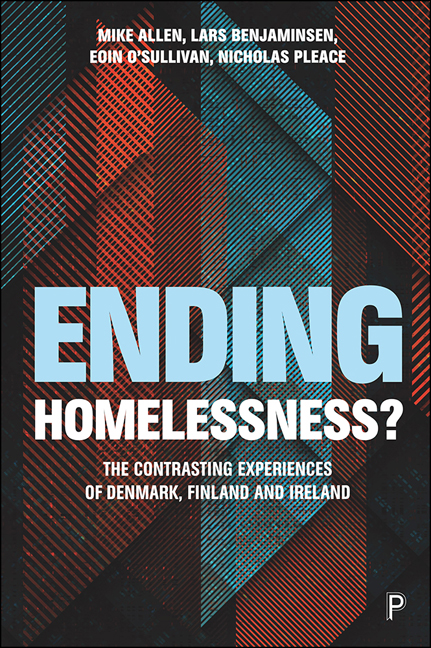Book contents
- Frontmatter
- Contents
- List of Figures and Tables
- Acknowledgements
- 1 Ending Homelessness? Policy and Progress in Denmark, Finland and Ireland
- 2 Before the Goal of ‘Ending Homelessness’: the Evolution of Policy
- 3 The Strategies Described
- 4 Trends in Homelessness in Denmark, Finland and Ireland
- 5 Explanations: Housing Matters
- 6 Explanations: Welfare and Politics Matter
- 7 Conclusion
- References
- Index
4 - Trends in Homelessness in Denmark, Finland and Ireland
Published online by Cambridge University Press: 25 February 2021
- Frontmatter
- Contents
- List of Figures and Tables
- Acknowledgements
- 1 Ending Homelessness? Policy and Progress in Denmark, Finland and Ireland
- 2 Before the Goal of ‘Ending Homelessness’: the Evolution of Policy
- 3 The Strategies Described
- 4 Trends in Homelessness in Denmark, Finland and Ireland
- 5 Explanations: Housing Matters
- 6 Explanations: Welfare and Politics Matter
- 7 Conclusion
- References
- Index
Summary
Introduction
This chapter outlines trends in recorded homelessness in the three countries between about 2008 and 2018/19. It first explores in some detail how homelessness is measured in each of the three countries. Each country uses a variety of methodologies to measure homelessness and it is important that the strengths and limitations of these different approaches are understood, particularly in relation to their comparability. In the case of Denmark, data from the national client registration system on homeless hostels are gathered by Statistics Denmark, in addition to a biennial count of adults experiencing homelessness conducted by the Danish Centre for Social Science Research. These two sources provide the basis for the measurement of homelessness in Denmark. Methodologically, the Finnish measurement is based on both administrative data and some estimates, based on a point in time in each year. Such an approach has its limitations, but as it is conducted on a consistent basis, it does allow for the reliable measurement of trends. In Ireland, data on homelessness are primarily based on administrative data via the Pathway Accommodation & Support System (PASS), a national bed-management system for homelessness services, and since April 2014, a monthly report on the number of households in designated homeless accommodation, broken down by gender, age and nature of accommodation, supplemented by a twice yearly survey of rough sleepers in Dublin. Data are also generated from PASS on a quarterly basis on entries to and exits from emergency accommodation, in addition to length of stay.
Of the three methodologies for measuring homelessness, the methodology in Denmark is the most sophisticated and robust, utilising as it does both administrative and survey data. As is well documented, comparative work on the extent of homelessness is beset with definitional issues (Busch-Geertsema et al, 2014; Pleace, 2016a). Having explored the full range of data on homelessness in each country, we then focus on those living rough, in emergency accommodation and in accommodation for the homeless. These are the first three categories in the European Typology of Homelessness and Housing Exclusion (ETHOS), which was described in Chapter 1.
- Type
- Chapter
- Information
- Ending Homelessness?The Contrasting Experiences of Denmark, Finland and Ireland, pp. 73 - 102Publisher: Bristol University PressPrint publication year: 2020



